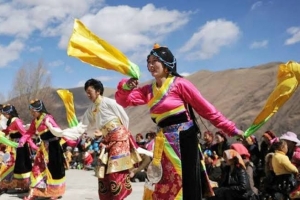The ancient Tibetan Mastiff breed has earned widespread admiration among dog enthusiasts around the globe due to their striking appearance, powerful demeanor and unique personalities. As natural guardians for Tibet’s harsh landscape – living for centuries at high-altitude environments with limited oxygen supplies, extreme cold and limited resources – Tibetan Mastiffs have developed remarkable survival strategies as well as exceptional adaption skills which enable them to adapt easily with their environment.
The Tibetan Mastiff breed can be divided into various different categories, with two of the more prevalent variations being “lion head” and “tiger head.” Lion-headed Tibetan Mastiffs feature thick manes around their neck and shoulders which give a majestic, lion-like appearance to this variety of dog. This type is most frequently seen in Tibet’s Nagqu area; on the other hand, the Tiger-Headed Tibetan Mastiff with its shorter coat and more muscular frame tends to populate Yushu in Qinghai and parts of Sichuan. Tibetan Mastiffs can also be divided into several bloodlines, such as Amdo, Kham and Tibetan types; each type displaying its own set of specific traits. Yet all Tibetan Mastiffs share one characteristic – an instinctive protective instinct which renders them invaluable guardians of both Tibetans and their livestock.

Appearance Characteristics of Tibetan Mastiffs: Power and Nobility
The Tibetan Mastiff is an impressive breed. Boasting large muscles, thick bones, and an athletic build; its presence exudes both strength and nobility. With broad heads featuring solemn expressions as well as double-layered coats tailored specifically for survival in extreme temperatures found on the Tibetan Plateau; Tibetan Mastiffs can be divided into longhaired and shorthaired types; long-haired specimens feature grand manes that add even further to its majestic presence while shorter-haired variations remain compact while maintaining strength within their athletic build and athletic build qualities.
Tibetan Mastiffs have proven themselves formidable protectors of the Tibetan Plateau over time. Highly alert and often hostile toward strangers, while remaining extremely loyal and protective toward their owners; such a combination has earned the Tibetan Mastiff not only trust from nomadic Tibetans but also among noblemen and kings of Tibet.
Life Habits: Loyalty and Resilience
Tibetan Mastiffs are well-known for their strong territorial instincts and protective nature; any intruder–whether animal or human–that enters their domain is considered an immediate threat, leading these dogs to serve a vital purpose: guarding livestock against predators. Even under harsh conditions found on the Tibetan Plateau, however, Tibetan Mastiffs maintain incredible physical strength and endurance that allow them to successfully perform even in difficult circumstances.
These dogs are notoriously independent. While not easy to train and may take more patience and time adjusting to unfamiliar situations or people, their territorial instincts lead them to explore and defend their environment quickly and regularly. Their strong-willed personalities make them excellent guard dogs but require owners who understand and honor this aspect of their nature as guardians as well.
Diet and Exercise: Balancing Needs for Health and Strength
Tibetan Mastiffs take an uncompromising approach to eating, indulging in quick gulps that sometimes result in competition among them for food. Living at higher altitudes has enabled these dogs to adapt successfully in low oxygen environments while remaining highly active – enjoying roaming large open spaces freely or playing together on large fields – helping develop strong bones and muscles early.
Tibetan Mastiffs are extremely sensitive to seasonal changes, particularly during their molting period. When temperatures fluctuate, Tibetan Mastiffs shed old fur to adapt for each coming season; during warmer months, this means shedding their heavy winter coat while during cooler weather months they grow thick fur protection to shield themselves against cold conditions.
Genetic Adaptations: Evolving for Survival in the Highlands
One of the Tibetan Mastiff’s most remarkable qualities is their remarkable capacity for living in low oxygen environments, and new research shows they possess unique genes which enable them to thrive on the high altitude climate of Tibet’s Plateau climate. Their genetic adaptations enable them to tolerate thin air and extreme cold – key features of survival for this breed in one of Earth’s harshest climates.
Tibetan Mastiffs have developed through genetic exchange with species like gray wolves to further their physical fitness and adaptability for harsh conditions in Tibet’s highlands. Such advantageous traits play an essential role in maintaining their reputation as guardian dogs for families living there.

Tibetan Mastiffs and Tibetan Tourism: Harmonious Coexistence between Nature and Culture
As the symbolic protector of the Tibetan Plateau, the Tibetan Mastiff serves not only as a beloved companion but is an integral part of Tibet’s rich cultural legacy. Sighted on nomad pastures all across Tibet with snowcapped mountains in view, these faithful protectors often serve as livestock guardians as well as home protection mechanisms – giving a peek into Tibetan history and traditions!
Tibet offers tourists an extraordinary cultural and natural heritage experience, from rugged beauty and historic significance of its landscape, to Tibetan Mastiffs guarding homes or roaming across vast plains – an unmistakeable reminder of how deeply integrated Tibetan society is with their environment and of how resilient life remains here today despite hardship. These magnificent animals symbolize both resilience and spirit of those that call this land home!
Traveling to Tibet allows visitors to witness this synthesis of nature, culture and history first-hand. For tourists exploring this sacred land for themselves, experiencing it through Tibetan Mastiff’s majestic appearance and unwavering loyalty offers an invaluable connection between land and people – something visitors won’t experience elsewhere.










